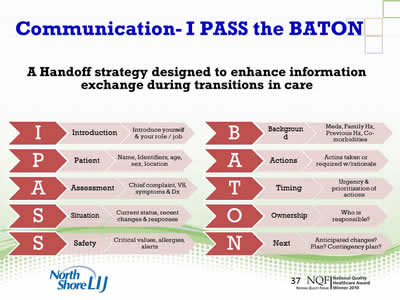



12- 15 Herein, we describe our quality improvement (QI) initiative to adapt, implement, and sustain I-PASS for handoff communication across various contexts at a pediatric teaching hospital. We selected the I-PASS program because of the strong evidence that its use reduces errors 9 and the emerging evidence that I-PASS can be adapted broadly across handoff contexts. In consideration of our hospital’s patient safety events, patient safety culture survey results, and focus group feedback, standardizing patient handoffs was identified as an institutional improvement priority. Central to the I-PASS program is its mnemonic, which represents 5 components of quality patient handoff: illness severity (I), patient summary (P), action list (A), situational awareness and contingency plans (S), and synthesis by the receiver (S). Starmer et al 10 described the I-PASS program curriculum that used successful tactics to address cultures that are resistant to change. I-PASS aims to help clinicians develop a shared mental model of each patient so that every clinician involved in the patient’s care can make decisions aligned with overall goals. I-PASS is a comprehensive handoff program that trains clinicians to exchange and synthesize relevant patient information concisely. Their study used rigorous methodology to demonstrate that the use of a structured handoff communication program, I-PASS, led to a 23% reduction in medical errors and a 30% reduction in preventable adverse events (AEs) among residents physicians at 9 pediatric hospitals. 8 More recently, a landmark paper by Starmer et al 9 reported improvements in patient safety through handoff standardization. Earlier studies showed that training clinicians to provide structured patient handoffs increased clinician comfort and patient information retention. Structured patient handoff processes can improve the fidelity of communication. Effective handoff communication skills need to be systematically taught, but few clinicians receive formal handoff education during training. 6 Clinicians across all disciplines regularly participate in some form of patient handoff or transition of care. Studies in teaching hospitals have documented 4,000 patient handoffs per day. 5 Approximately half of these communication failures occur during patient handoffs, which are pervasive in current healthcare systems. 3, 4 The Joint Commission reported communication failures as the root cause of most sentinel events. While controversy exists regarding the number of patient deaths that result from medical errors annually, 1, 2 experts agree this is a significant problem in healthcare.


 0 kommentar(er)
0 kommentar(er)
